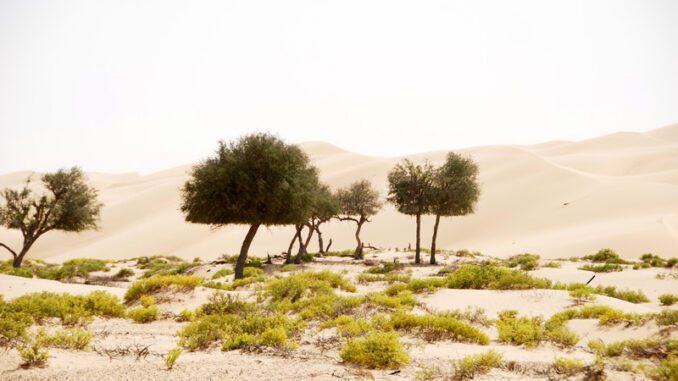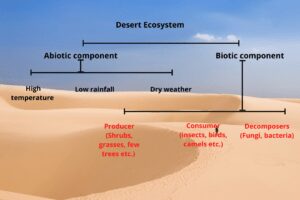
Introduction
The desert ecosystem is one of the major ecosystems on the earth. Desert ecosystem types are warm, cold, and semi-arid. It covers about 17% of the earth’s surface.
Earth consists of the atmosphere, ecosystems, and various elements. There are deserts in almost every continent of the world. The ecosystem of the desert is known as the desert ecosystem.
An ecosystem is a close relationship between different organisms in a particular region and their surrounding physical and chemical environment. Desert ecosystems develop in areas with very low annual rainfall with high or low temperatures. The initial productivity of the desert ecosystem is very low. The desert receives less than 50 cm of rain each year. It can be both hot and cold and is a large barren abandoned and dry sand-covered area (1) & (5).
Desert Ecosystem Types & components Video
Desert ecosystem
- The desert ecosystem is the driest terrestrial ecosystem in the world, therefore, it has less biodiversity.
- The plants in this desert ecosystem are usually short-lived in nature. They grow, germinate, and perish in a very short time.
- In this type of ecosystem, thorny shrubs are scattered around. The roots of these plants extend far below the ground. Their roots are located at a depth of 1 meter from the surface. As a result, they can easily collect rainwater. In many cases, their leaves are transformed into thorns to reduce the cost of water through evaporation.
- Desert plants are capable of photosynthesis because their stems are green and succulent and covered with a waxy substance.
- Different types of animals such as locusts, camels, rats, etc. are seen in the desert ecosystem. The animals of this ecosystem adapt to the different conditions prevailing in the desert ecosystem. (2) & (5).
Interesting facts about the desert ecosystem
There are some features of the desert ecosystem. These are as follows
- An extreme temperature difference is there in the day and night of a desert ecosystem. It is very hot during the day and very cold at night.
- Low rainfall is one of the main characteristics of the desert ecosystem. The amount of annual rainfall here is only 25 to 30 cm. So the desert ecosystem is arid in nature.
- Cactus are commonly found in this ecosystem as they can easily survive in this environment.
- Due to the lack of water, the population density in this ecosystem is very low.
- The soil of the desert ecosystem is not ideal for growing plants. So the amount of plants growing here is very low. The soil here is dry, rocky, and sandy in nature. These soils do not have any organic matter like nitrogen, or phosphorus.
- Humidity is low during the day and relatively high at night in the desert ecosystem.
- The water crisis occurs due to low rainfall in the desert ecosystem as a result there is a drought for half of the year.
- This ecosystem has mounds of many sizes, large and small, resulting in high-intensity sandstorms and dust storms (3) & (5).
Component of a desert ecosystem
The desert ecosystem has less density of plants due to low rainfall. These regions are characterized by less than 255 mm of rainfall and high or low temperatures. The evaporation rate of this ecosystem is very high. Dates, cotton, millet, etc. are cultivated in different places depending on the availability of water. Like other ecosystems, desert ecosystems are made up of some biotic and abiotic elements (2) & (4).
Abiotic components of the desert ecosystem

The abiotic components of desert ecosystems are soil, high temperature, low rainfall, and dry climate. These severely affect the desert ecosystem.
1. High temperature or low temperature
Desert ecosystems usually have either high or low temperatures. Along with this hot deserts have a difference in day and night temperature. During the day, the temperature reaches a high point due to the heat of the sun. And very cold weather prevails at night. The temperature drops below zero degrees. Organisms that cannot adapt to these temperatures have difficulty surviving in the desert. The temperature range in this ecosystem is extremely high (2) & (4).
2. Soil
The nature of the vegetation in that region depends on the type of soil in all ecosystems. Plants grow according to the type of soil. Desert soils do not have any organic matter like nitrogen, phosphorus, etc. which are essential for plant growth. In the desert ecosystem, the soil is dry and rocky, sandy. The soil is not ideal for plant growth therefore, there are no big trees. Cactus is the most common plant in the desert ecosystem. In some places dates, cotton, and millet are also cultivated (2) & (4).
3. Low rainfall
Low rainfall is a major feature of desert ecosystems. Rainfall is usually less than 500 mm per year. The plants and animals that live in this desert ecosystem must be able to survive with little water. Cactus develop by storing water in their stems during the rainy season (2) & (4).
4. Sunlight
Sunlight is an important element of the desert ecosystem. This deeply affects the flora and fauna of the ecosystem (2) & (4).
Biotic components of the desert ecosystem
The biotic components of desert ecosystems are producers, consumers, and decomposers.
1. Producers
Grasses, thorny bushes, and some species of trees like zizyphus, acacia, etc. are the producers of the desert ecosystem. And many species of succulents like euphorbia, agave, asparagus, etc. also grow in this ecosystem known as xerophytes. All of these plants can adapt to low rainfall and high temperatures (2) & (4).
2. Consumers
Rats, goats, rabbits, camels, and many species of birds are the primary consumers of the desert ecosystem. The secondary consumers in the desert ecosystems are many species of reptiles, insects, owls, etc. Other prey animals are tertiary consumers of the desert ecosystems. The primary consumers survive by taking the producers as food. And the secondary consumer survives by eating the primary consumer. The tertiary consumer takes primary and secondary consumers as food. In this way, the food chain is maintained in the desert ecosystem (2) & (4).
3. Decomposers
The number of decomposers in the desert ecosystems is very low. Some fungi, bacteria, etc. are the decomposers of the ecosystem. They decompose dead plants and consumers in desert ecosystems into simple chemicals (2) & (4).
Type of desert ecosystem

Fig: Location of the desert ecosystem
Desert ecosystem types are warm desert ecosystems, semi-arid desert ecosystems, and cold ecosystems (4).
1. Warm desert ecosystem
The climate of this ecosystem is hot and dry. The amount of annual rainfall here is very low. The Sahara of North Africa, the Kalahari of South Africa, the Thar of India, the desert of Mexico, the Australian desert, California, and the Arizona desert, etc. are examples of hot desert ecosystems. In this ecosystem, extreme temperature changes occur and the soil becomes rough.
2. Semi-arid desert ecosystem
This ecosystem has small dunes, hard rocks, etc. The climate of this ecosystem is different from that of the hot desert ecosystem. The amount of rainfall is higher in this desert ecosystem than in a normal desert ecosystem. The Great Basin of North America is an example of a semi-arid desert ecosystem.
3. Cold desert ecosystem
The climate of this desert ecosystem is very cool. This ecosystem receives rainfall in winter. The amount of rainfall here is very low in summer. It has large snow mounds. Greenland and the Antarctica region desert are examples of cold desert ecosystems.
Oceans and coastal lines also have ecosystems. These ecosystems also have extreme conditions and thus are the type of desert ecosystem, therefore, are called coastal desert ecosystems. The diversity of plants and animals in this ecosystem is higher than in other ecosystems. The Atacama is an example of a coastal desert ecosystem.
Importance of the desert ecosystem
Like other ecosystems, desert ecosystems occupy a significant place in the world. This ecosystem plays an important role in maintaining the balance of the earth despite the low rainfall and dry climate.
- This ecosystem is a habitat for many species of plants and animals. These animals and plants balance by establishing relationships with each other.
- Different types of bacteria are present in the sand of the desert ecosystem. These bacteria can store carbon dioxide. And acts as a carbon sink, preventing carbon dioxide from entering the atmosphere.
- These ecosystems are often the source of mineral resources and natural gas.
- It is a very beautiful ecosystem. It has different types of landforms and oases. The natural beauty of this system attracts people from all over the world. So these ecosystems play an important role in the tourism industry (1) & (6).
Many types of animals and plants can be seen beside the harsh climate of the desert ecosystem. All these plants and animals adapt to this environment and live there. This results in the accumulation of different biodiversity in this ecosystem. And this ecosystem becomes attractive.
Presently due to climate change, the desert ecosystems are facing so many problems. Global warming is one of the main issues and its effects are most noticeable in warm deserts. Due to the temperature rise, many plants and animals present in the desert ecosystem are facing challenges related to food and their survivability.
